 Leading Blog | Posts by Month |
 Leading Blog | Posts by Month |
10.30.06

Being RelevantDetermining what matters is the one of the first tasks of a leader. Peter Drucker wrote, “The right answer to the irrelevant question misdirects. But the wrong answer to a relevant issue still puts the spotlight where it belongs.” One can be right but irrelevant. What matters, what is relevant is dictated objectively by the situation one find themselves in. Determining what is right on complex issues can be daunting and take time, but it is vital that the issue we are working on is relevant. A leader’s job is not necessarily to solve the problems at hand, but to get us thinking about the right problems at the right time. A leader might also make use of what Andy Grove calls helpful Cassandras. You may remember from Greek Mythology, Cassandra's great beauty caused Apollo to grant her the gift of prophecy. Helpful Cassandras are those people that can help a leader see other points of view, people that are willing to be blunt, so that a leader doesn’t win an argument they ought to lose.
Posted by Michael McKinney at 12:20 AM
10.28.06

They Came, They Conquered, They Collected: What Dictators Collect An article in Psychology Today by Caroline Tiger asks the question, "What drives the need for dictators to collect material possessions that are over the top?" Tyrants collect money and power, but they also amass bric-a-brac like the rest of us. What, if anything, do their material leanings signify?
Posted by Michael McKinney at 09:23 AM
10.27.06

Five Qualities of Great LeadersIn The Nature of Leadership, Joseph White writes,"To be a great leader, you have to be successful at achieving change—important, consequential change in the results for which you are responsible. Making change successfully is a leader's greatest challenge." To this end a great leader utilizes the following qualities to produce results and make change.
Posted by Michael McKinney at 04:30 AM
10.26.06

Assertiveness: The Meekest and Mightiest Make the Worst LeadersBalance. Easy to understand, tough to practice.The overuse of strength creates a weakness. Every strength has a point where it becomes a liability. Maturity and self-control help to rein in the excesses of our personality. Not surprisingly, recent research by Stanford professor Frank Flynn has found that the greatest identifiable trait that can hold someone back from becoming a great leader is being too assertive—or not assertive enough. In other words, assertiveness that is out of balance. In the Stanford Graduate School of Business News, Marguerite Rigoglioso reports: Analyzing three years’ worth of written and survey data on students, as well as students’ assessments of their own former bosses, Flynn and Ames found that excessive or inadequate assertiveness was the No. 1 issue listed in the weakness column when it came to evaluating individuals’ leadership potential. “It was mentioned twice as frequently as any other issue. It appeared as a clear factor in weakness comments more than lack of intelligence, conscientiousness, and charisma combined,” Flynn says. Specifically, what the researchers found was essentially an “inverted U” between the ratings of a person’s assertiveness and his or her leadership ability: Up to a certain point it was positively associated, but then it went back down.
Posted by Michael McKinney at 12:32 AM
10.25.06

The Neuroscience of Leadership Webinar
Posted by Michael McKinney at 10:05 AM

Neurogenesis: Environment Matters to the Brain
ELIZABETH GOULD's research in neurogenesis—the process of creating new brain cells—is adding to our understanding of how our environment directly affects the quality of our thinking. A professor of psychology at Princeton University, she is changing our understanding of the production of new neurons and the plasticity of the brain.  The brain is a remarkably pliable organ that is greatly influenced by our surroundings. In chronically boring environments or stressful conditions, the structure of the brain is altered. Brain cells starve and retreat and new cells are not created. Yet remarkably, the brain can also heal itself. When the environmental conditions are enriched the brain begins to create new brain cells and the density of neuronal dendrites (the branches that connect one neuron to another). It would seem design—in all its various forms—matters. In an article in Seed magazine, writer Jonah Lehrer reports on Gould’s research: The subject of stress has been the single continuous thread running through Gould’s research career. From the brain’s perspective, stress is primarily signaled by an increase in the bloodstream of a class of steroid called glucocorticoids, which put the body on a heightened state of alert. But glucocorticoids can have one nasty side-effect: They are toxic for the brain. When stress becomes chronic, neurons stop investing in themselves. Neurogenesis ceases. Dendrites disappear. The hippocampus, a part of the brain essential for learning and memory, begins withering away. The research should give us pause to consider the environment we function in and the environment we create for others to perform in.
Posted by Michael McKinney at 09:00 AM
10.24.06

Henry Mintzburg and Frank Brown on Teaching Leadership
THE FINANCIAL TIMES published in a special section on Business Education, a leadership debate between Henry Mintzburg and Frank Brown that has gotten a lot of attention.  At the core of what he takes issue with is the way leadership is portrayed. And rightly so. He has a problem with leaders being presented as “the great one who rides in on a white horse.” It gives the impression that the leader did it all by themselves. He adds: “We have too much of this leadership apart—the hyped-up, individually focused, context-free leadership so popular in the classrooms as well as the press. Courses and MBA programmes that claim to create leaders all too often promote hubris instead. No leader has ever been created in a classroom.” How true. Leadership studies do need to be reconsidered. The current methodology no doubt lead Stanford’s James March to say the following in a recent interview in the Harvard Business Review: I doubt that “leadership” is a useful concept for serious scholarship. The idea of leadership is imposed on our interpretation of history by our human myths, or by the way, we think that history is supposed to be described. As a result, the fact that people talk about leaders and attribute importance to them is neither surprising nor informative. Leadership cannot be taught in the sense that a person can sit in a classroom and walk away a leader any more than one can read a leadership book every week and call themselves a leader. It is possible, however, to teach principles, to lay the groundwork for a way of thinking and to create awareness of traits and characteristics. But until a person combines all of that with their own thinking and character, making it a part of who they are, they are not a leader. And that simply takes time and practice. There is no short-cut to leadership. The leadership journey is an ongoing journey into self-knowledge or awareness. It is a process of reflection to see where you stand in relation to where you should be and determining the steps you need to take in order to get there. Mintzberg’s problem with the conventional MBA classroom is the way it is taught—overemphasizing the science at the expense of its practice and the kinds of “leaders” it tends to generate—MBAs that are too young, and have too little experience to appreciate what they are being taught. That is to say, it tends to produce heroic-type leaders that have no experience to fully understand the world they are charging-in to. As Mark Twain said, "When I was a boy of 14, my father was so ignorant I could hardly stand to have the old man around. But when I got to be 21, I was astonished at how much the old man had learned in seven years." It is astonishing how much these “leaders” find there is to learn after they’ve been out in the workplace for a while that never found a place—or they were never able to make a connection to—in the classroom. 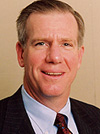 To get the experience and practice necessary to become leaders, Frank Brown, former dean of INSEAD (currently Managing Director & Chief Operating Officer at General Atlantic), writes, “Indeed, true leaders are committed mentors and supporters for training and development initiatives that allow employees to climb the leadership ladder.” He continues: Simply said, the last thing the business world needs is more managers. On the contrary, it is in need of more leaders. On teaching leadership in the classroom you might take a look at Leadership Can Be Taught by Shanon Daloz Parks regarding Ronald Heifetz’s efforts at Harvard. An important book in the area of leadership development is Welter and Egmon’s book, The Prepared Mind of the Leader, for this is where leadership really begins.  
Posted by Michael McKinney at 12:42 AM
10.23.06

The Nature of Leadership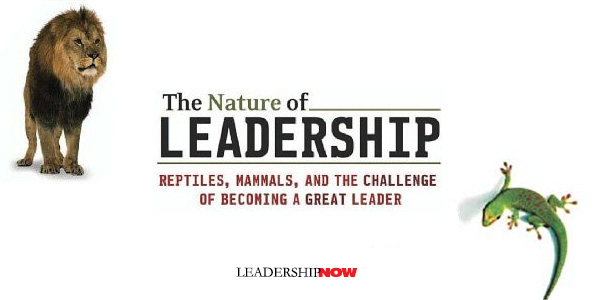
A SURPRISE in this month’s crop of books is The Nature of Leadership by B. Joseph White. Essentially, it is a blueprint for leadership development. He has created a leadership pyramid founded on basics such as a desire to be in charge, and the corresponding ability, strength, and character that all leaders—especially the great ones—must possess.
White cautions, “I make no judgment about the inherent value of Reptiles and Mammals in the workplace. Both are vital and most people are, of course a complex mix of the two. We need task-oriented, no-nonsense Reptiles to ensure the work gets done and done well. We need people-oriented, nurturing Mammals to maintain the human community through which work gets done.” He adds, “I believe organizations falter, fail, or don’t reach their potential both because of leadership that is inadequately Reptilian and because of leadership that is inadequately Mammalian.”
You can read Chapter 1 online: Become a Leader, a Better Leader, a Great Leader 
Posted by Michael McKinney at 05:51 AM
10.20.06

Focus on the War, Not the Battle
EARLY Christian philosopher, Augustine of Hippo (354-430), proposed that to drive out the bad—those habits or qualities we don’t want—we need to focus on the good—those habit, qualities or strengths we do want. At home, this was always referred to as focus on the war, not the battle. The implication is that when we have a problem we want to change, we need to focus on the new habit we want to form and not the bad habit we want to replace. In relationships, we need to focus on the good that we want to develop and strengthen and not the bad we would like to drive out. Focus on the strengths and they will drive out or minimize the weaknesses. There seems to be some support for this in current studies of neuroplasticity. Our brain physically changes—makes new connections—based on what we pay attention to; it moves in the direction of our most dominant thoughts. Jeffrey Schwartz and Sharon Begley write in The Mind and the Brain, “Physical changes in the brain depend for their creation on a mental state in the mind—the state called attention. Introspection, willed attention, subjective state—pick your favorite description of an internal mental state—can redraw the contours of the mind, and in so doing can rewire the circuits of the brain, for it's attention that makes neuroplasticity possible." We literally change our brain consistent with that which we send our time thinking about. Shouldn’t we then be thinking about where we want to go and not the miles we have to go to get there? In terms of leadership, David Rock writes in Quiet Leadership, “[W]e need to help people focus on solutions instead of problems. We need to give up our desire to find behaviors to fix and become fascinated with identifying and growing people’s strengths.” Focus on the war—the desired end—and not the battle—the obstacles we face in getting there.
Posted by Michael McKinney at 08:32 AM
10.18.06

Hiring Teams as the Talent
OFTEN overlooked in the rush to find that one person that can make a difference in your organization is the context that that superstar worked in. Rarely is an individual great of and by themselves. It usually requires a team of people working together in a great environment to make something great happen. Taking the superstar out of that context can often lead to less-than-great performance. Consider this: Thinking of and hiring the team as the talent may be what we should be looking for when trying to hire-in great performance.  One of the most interesting findings … was that GE executives who brought along 3 or more GE alumni to join their teams had “annualized abnormal returns” of 15.7% above average; while those that hired one or none from GE had -16.7%. Groysberg and his colleagues call this past experience working together “relationship human capital,” horrible language from economics. Other researchers call it “prior joint experience,” which isn’t much better. But whatever you call it, while HR practices turn attention to individual stars, study after study shows when people have experience working together – and have learned who knows what, how to read those little signals that people send off, and can communicate ideas quickly and efficiently – their teams and organizations perform better.
Posted by Michael McKinney at 03:50 PM
10.16.06

Grassroots Change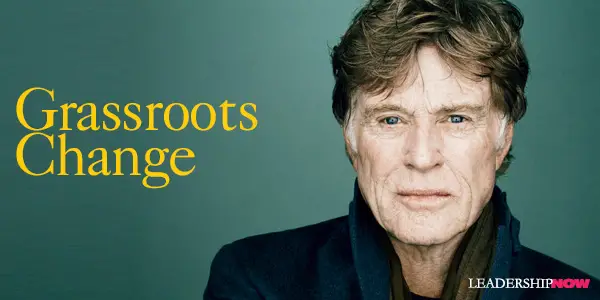
Robert Redford has focused considerable energy at bringing about change on issues that are important to him. Common sense or emotional intelligence will tell you that the best way to change things is not to charge in. You can be results-driven without being a bull-in-a-china-shop. Change can begin at any level. In a Harvard Business Review article, Turning an Industry Inside Out: A Conversation with Robert Redford, he notes two approaches to change in an organization or industry: top-down and bottom-up. The former is the more difficult and the latter takes longer and requires considerable skill and patience. Some lessons he has learned over the last 20 years:
Posted by Michael McKinney at 09:47 AM
10.13.06

How To Fine Tune Your Listening Skills
“Why do most of us like to talk so much? Because we want to be noticed. We get a charge out of being the center of the universe. But when you yap on, you use up all of the oxygen and energy in the room, which is debilitating for everyone else” say authors Linda Kaplan Thaler and Robin Koval in The Power of Nice. Often times, more communication is less communication. They suggest five ways to fine tune your listening skills: Let the Other Guy Be Smarter. When you let the other guy’s brilliance shine through, you not only gain new information, you also earn their goodwill. Everyone likes to be around people who make them feel intelligent. Keep It Simple. Sometimes the simplest answer is the best one. By listening rather than pontificating you will often hear the simple connection that makes the difference. Ask, Don’t Tell. When you ask questions, you tell people that you care about them, that you’re interested in what they have to say. You also send an oh-so-subtle message that you’re a bright, inquisitive individual who would like to know more. That’s why even the smallest question can have a huge impact. Don’t Argue So Much. Whenever problems or conflicts arise, there is a natural tendency to try and “talk your way out of it.” But sometimes you win your case by shutting up and listening your way out of it. Everyone Is Worth a Listen. Jay Leno says, “We live in a society of exclusion. There is this idea that you should try to keep people out—‘Oh, you can’t come into this club, you have to be a member, you don’t have enough money, you’re not handsome enough.’ But if you go through life with the opposite attitude and try to include everybody, it opens up doors.” Remember Dale Carnegie's quote: "You can make more friends in two months by becoming interested in other people than you can in two years by trying to get other people interested in you." 
Posted by Michael McKinney at 08:59 AM
10.12.06

Warren Buffett on Ethics On backdating, Buffett wrote, “My guess is that a great many of the people involved would not have behaved in the manner they did except for the fact that they felt others were doing so as well.”This once again underscores the point that there is most often a difference between what is legal and what is right or ethical. Legally we may be allowed to behave in ways that are not ethical. We are allowed to conduct ourselves in ways that we would not like to see others doing to us. Legal is about what we can get away with. Ethical is about what is right. The spirit of the law sometimes looks very different than the letter of the law.
Posted by Michael McKinney at 12:02 AM
10.11.06

What is Trust?
David Abshire, President of the Center for the Study of the Presidency, in a speech delivered this summer had this to say about trust:
Posted by Michael McKinney at 08:59 AM
10.09.06

Carly Fiorina On Leading Change
RECOUNTING her days at Lucent, Carly Fiorina writes in Tough Choices about the challenge of bringing about organizational change:  As is true whenever a new leader issues a challenge, a critical mass of the old-timers must rise to that challenge. If this fails to happen, the new leader is simply ignored. People who’ve never operated in large, complex companies are often surprised to learn that even a change agent with title and position can be effectively rendered powerless by people’s collective decision to maintain the status quo. A boss can hire and fire. A boss can reallocate people and money. A boss can measure and reward. A boss can threaten or inspire. Each of these actions and decisions will be analyzed and interpreted by an organization. Some interpretations will motivate change. But no boss, even a president or a CEO, can order people to change. No boss can force people to behave differently. People operate based on their own free will. They will make their own decisions, and in big companies, those decisions are easy to hide. 
Posted by Michael McKinney at 08:18 AM
10.08.06

Carly Fiorina: Hewlett-Packard Leaks
THE New York Times reported Thursday (October 5) that according to former Hewlett-Packard chief executive Carly Fiorina, she “ordered the first of a series of leak investigations into contacts by board members with journalists in January 2005.” In her new book, Tough Choices, she writes that it began with the leak of a January 2005 meeting to the Wall Street Journal. After a suggestion by Larry Babbio that every Board member should resign, she wrote, “I suggested instead that we ask the Nominating and Governance Committee to launch an investigation to be conducted by outside counsel. On rare other occasions when we’d had an ethical issue arise in the company that warranted the Board’s attention, the Audit Committee had conducted an investigation with outside counsel. Because this was a matter internal to the Board, I felt the Nominating and Governance Committee should handle this one. No one argued.” Fiornia continues: Bob Knowling convened the committee by telephone ten minutes later. The members agreed that Larry Sonsini would interview each Board member. Bob requested that Larry use the interviews to conduct not only an investigation but also an objective assessment of the Board. Beyond the leak, there was much about the Board’s dynamics that was disturbing. The committee agreed. Each Board member should be asked their views of the effectiveness of the Board, the qualifications of each Board member, and how we could improve our meetings and deliberations. I thought it was a great idea. We needed to know what had happened to ensure that it never happened again, but perhaps we could also accomplish something more positive and productive. I thought we could weather this storm; we had weathered so many. I didn’t expect anyone to resign over this, nor did I intend to ask. I thought this could be a useful wake-up call to several board members who were not as smart as they thought they were. 
Posted by Michael McKinney at 06:15 PM
10.05.06

Teaching Leadership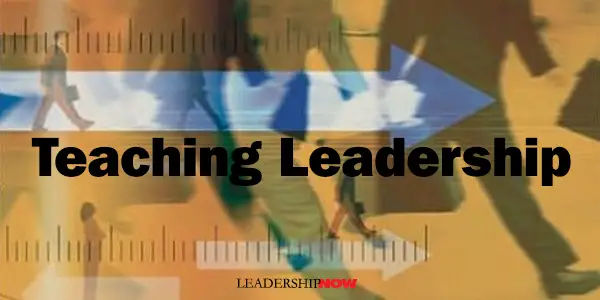
This summer author Paul Taffinder spoke to the Wall Street Journal Online about teaching leadership: I wouldn't say anyone is born a leader. There have been some studies that indicate people who have been exposed to psychologically traumatic experiences are better leaders. They've had to overcome trials and tribulations. So they're more inclined to be challenging and look deep within themselves for what they believe in. Leaders like that learn to be clear about the story they're telling about where they have come from and where they're going.Paul Taffinder’s book The Leadership Crash Course helps to translate lessons learned into practical applications to improve your leadership skills. Looking at the basic personal and emotional components of leadership, the book offers a series of modules that individuals at many levels can study, deploy and refer to from time to time. The lessons are geared toward diagnosing your own behaviors and then applying different techniques to leverage strengths and improve development areas. His web site has interactive tools to further explore your leadership style and preferences. 
Posted by Michael McKinney at 08:58 AM
10.04.06

Teaching as MarketingSeth Godin wrote an excellent post on his blog about communication through speeches or talk. He writes about the dynamics of speech: “Speech is both linear and unpaceable. You can’t skip around and you can’t speed it up. When the speaker covers something you know, you are bored. When he quickly covers something you don’t understand, you are lost.” This is both the advantage and the challenge of speech.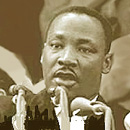 A speech has always been a platform to sell ideas, but we often forget that and just drone on presenting what perhaps is important to us (often the audience can’t tell) without regard to our listeners. Godin adds, “If marketing is the art of spreading ideas, then teaching is a kind of marketing. And teaching to groups verbally is broken, perhaps beyond repair. Consumers of information won’t stand for it. We’re learning less every time we are confronted with this technique, because we’ve been spoiled by the remote control and the web.” Godin suggests, “If you teach—teach anything—I think you need to start by acknowledging that there’s a need to sell your ideas emotionally. So you need to use whatever tools are available to you—an evocative PowerPoint image, say, or a truly impassioned speech.” Speech isn’t broken; we just don’t take the time to do it well. A well crafted speech has the potential to cut through the clutter and hold your attention more intimately than nearly any other form of communication.
Posted by Michael McKinney at 12:17 AM
10.03.06

Leadership in Action is About Dilemmas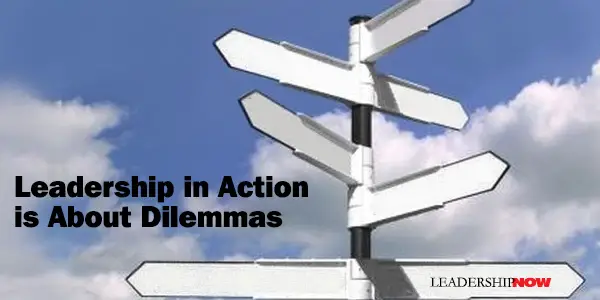
Paul Taffinder writes in The Leadership Crash Course that leadership in action is about dilemmas. In an age where we have more choices than ever before, the leader’s job becomes more urgent. The problem isn’t necessarily that we have so many choices, but what we base our selection of choices on. The leader’s job is to guide this process. This might be called imposing context. This speaks to the need we all share for a framework within which to live. Context takes into account where we have been and where we are and where we want to go. The leader must add to the conversation those things that need to be considered to make proper choices. A leader should help to cut through the clutter and help people to consider especially those things beyond the realm of selfish concern. Ironically, getting where we want nearly always means not getting what we want. Leader’s frequently must guide people through behaviors and places they would never choose for themselves if left to their own desires. In a society that wants to achieve the desired ends by simply going straight to the desired ends and short-circuiting the necessary intermediate steps, this can be quite a challenge. At times like these, a leader’s self-knowledge becomes all the more important. 
Posted by Michael McKinney at 08:44 AM
10.01.06

Leadership Books: October 2006Here's a look at some of the best leadership books being released in October. For a look a little further out see the Winter 2006 releases.    
Posted by Michael McKinney at 12:11 AM
|
BUILD YOUR KNOWLEDGE


How to Do Your Start-Up Right STRAIGHT TALK FOR START-UPS 
Grow Your Leadership Skills NEW AND UPCOMING LEADERSHIP BOOKS 
Leadership Minute BITE-SIZE CONCEPTS YOU CAN CHEW ON 
Classic Leadership Books BOOKS TO READ BEFORE YOU LEAD |
|